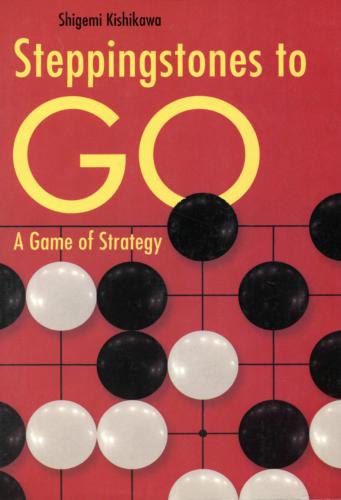Stepping Stones to Go. Shigemi Kishikawa
captured are used to fill up the vacant spaces claimed by the opponent. The winner is the player who has succeeded in occupying the larger territory after the captured stones are used in this way.
With this ultimate object in view, two plans of action are followed, one being simply to rail off space by forming walls of stones around the area which the player desires to occupy, and the other that of capturing the stones or space of the opponent. However, if the players merely fence in parts of the board regardless of each other's play, a dull and monotonous game results. More interesting games develop when the players, in their efforts to secure territory, attack each other's stones or space, as will be explained later. The game is concluded when neither player is able to secure further unoccupied territory and when neither is willing to hazard further attacks on the territory already surrounded by his opponent.
The rules of play
Black plays first, placing one of his stones on any intersection on the board. Thereafter Black and White play alternately.
Aside from some rules relating to specific situations (explained later), all the necessary basic rules to play go are as follows:
1. The board must be so placed that the narrow sides are immediately opposite each player.
2. The stones are played on the points of intersection of the lines. As mentioned in Chapter 1, once placed they are not moved except when captured or for counting purposes at the end of the game.
3. With evenly matched players, the right of first move is decided by having one player hold a handful of stones and his opponent calling odd or even. If the opponent guesses correctly, he wins the black stones, and has the advantage of playing first.
4. When players are not evenly matched, the weaker player is given a handicap and he uses the black stones. In this case, White has the first move, and Rule 3 is ignored.
5. When all of the intersections adjacent to a stone or a group of stones are occupied by stones of the opponent, that stone or group of stones is captured and removed from the board.
6. It is forbidden to play on any point which is completely surrounded by the opponent's stones and there is only the one point vacant, unless the play results in the capture of all or part of the surrounding stones, because no stone may remain on the board if it is completely surrounded by stones of the opposite color.
7. If a group of stones contains two separate "eyes" (explained in detail in Chapter 6), it is permanently safe from capture, regardless of the enemy stones surrounding the group.
8. In a ko position (described in detail in-Chapter 9), a player cannot repeat his previous move without first playing at some other part of the board.
9. To arrive at the final score, White counts the points within Black's territory and Black counts White's. To facilitate counting, the respective territories should be arranged as far as possible in rows of tens and twenties. Stones may be transferred from one place to any other place for this purpose.
Observers are not supposed to make comments. Even nowadays boards with four legs have a hollow on the reverse side in which in olden times the gory head of the interfering bystander was placed as a hint to others.
It is usually considered impolite to make the first move upon the central point of the board except in handicap games. At the end of the game, the stones should be returned to each player and not left in position.
Although not a part of the rules of the game, it seems appropriate here to describe briefly the purpose of handicaps. Before commencing play, handicaps are given by the stronger player in order to equalize the game between the two contestants. The placing of handicaps is shown in Diagrams 2-9.
Though only nine points are marked on the board, handicaps of 13, 17, and even 21 are given by advanced players to beginners. However, handicaps larger than nine stones are seldom practicable. Therefore, the nine-stone handicap is ordinarily the recognized maximum.
In the beginning, progress at playing go is very rapid, and handicaps are reduced very quickly. Usually, four, or sometimes three, wins cause a decrease of one stone in the handicap allowed. When handicaps are given, Black loses his right to first move since he has the advantage of stones already on the board.
Diagram 2
A two-stone handicap
Diagram 3
A three-stone handicap
Diagram 4
A four-stone handicap
Diagram 5
A five-stone handicap
Diagram 6
A six-stone handicap
Diagram 7
A seven-stone handicap
Diagram 8
An eight-stone handicap
Diagram 9
A nine-stone handicap
•3•
Territory
In the preceding chapter you learned that the primary object of go is to secure territory with your stones. The vacant areas surrounded by the players' stones are called territories, and each point of intersection is counted as one point in the possessor's favor. Let's study the diagram shown overleaf.
Конец ознакомительного фрагмента.
Текст предоставлен ООО «ЛитРес».
Прочитайте эту книгу целиком, купив полную легальную версию на ЛитРес.
Безопасно оплатить книгу можно банковской картой Visa, MasterCard, Maestro, со счета мобильного телефона, с платежного терминала, в салоне МТС или Связной, через PayPal, WebMoney, Яндекс.Деньги, QIWI Кошелек, бонусными картами или другим удобным Вам способом.
